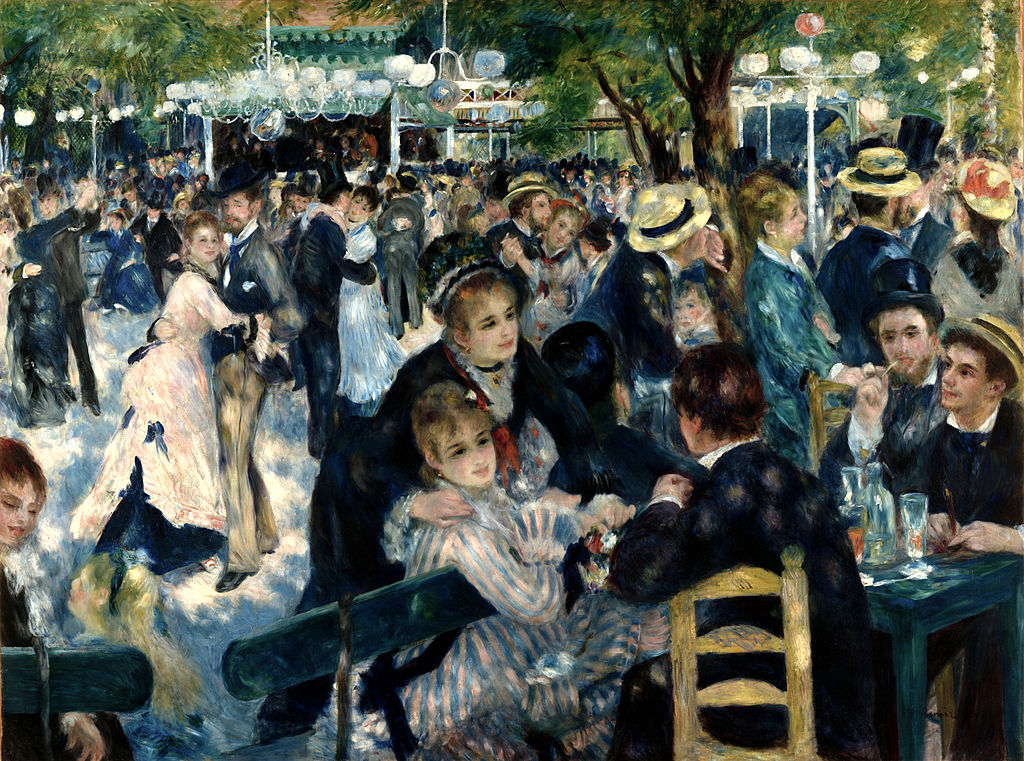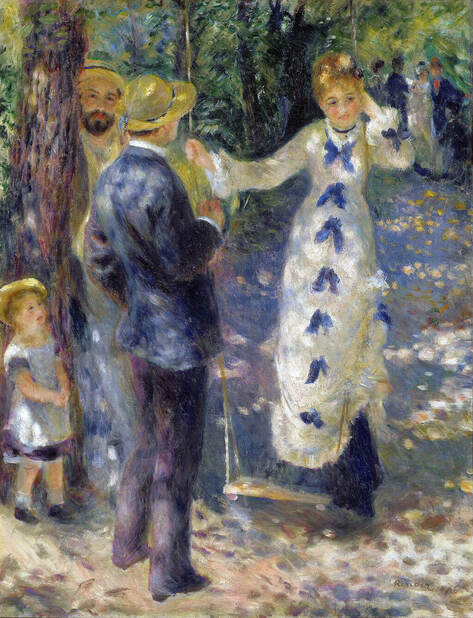|
Where? Room 31 of the Musée d'Orsay
When? 1876 What do you see? An open-air dance in Montmartre (a hill and district in Paris). On the table in the foreground sits a 16-year old model in a striped dress. Her name is Estelle. Probably, her older sister, Jeanne Samary, stands behind her and is in conversation with the painter Franc Lamy. Renoir used Jeanne Samary more often as a model for his paintings, such as in The Swing which is also in the Musée d’Orsay. The man on the right side of the other side of the table is George Rivière, the biographer of Renoir, and the man smoking a pipe on the left is the printmaker Norbert Goeneutte. Behind the seated people in the foreground, people are dancing under the acacia trees. The dancing women are mainly local people, and the men are mostly friends of Renoir. On the bottom left, a child is playing with her mother. This painting may be painted on a Sunday afternoon when the dance hall was open to families with children. On the top, we can identify some chandeliers that are hanging in the trees, as well as some lights on a pole on the right.
The effects of light: Renoir paid careful attention to the effect of the sunlight on the dancing people. It seems to be a sunny day, but the trees block part of the sunlight. We can see the brighter and darker areas in the painting by looking at the ground and the colors of the dresses of the woman. Look also at the man sitting with his back toward us in the right foreground. He has some light patches on his jacket and head. This is the result of the sunlight shining through the trees.
Backstory: This painting is also known as ‘Bal du Moulin de la Galette’ and ‘Au Moulin de la Galette.’ Moulin de la Galette was the name of a neighborhood dance hall located next to a windmill (moulin is French for windmill). Renoir also painted a smaller version of this painting which is in a private collection. In that version, he leaves out more details. This painting was sold in 1990 for $78.1 million, which is still a record for a Renoir painting. It is uncertain which of the two versions has been painted first. The current version is in the Musée d’Orsay since 1986 when it was transferred from the Louvre. Renoir used loose brush strokes to paint this work, and the painting lacks quite some detail. On the Impressionist exhibition where this painting was first shown to the public, some people were confused and thought that Renoir did not finish his painting yet. However, Renoir left out many details on purpose as he understood that the human eye could fill in the details when looking at the painting. This allowed him to focus on the effects of light and movement, and create a bright and happy painting of the public dance. Open-air dance halls? The Moulin de la Galette was an open-air dance hall in Paris in the 1870s. Open-air dance halls were very popular in 19th-century France and were a great source of entertainment for the people. Most people went there not to dance, but just to watch the dancers and enjoy the relaxed atmosphere. Renoir is the only Impressionist artist to depict this theme in his paintings. Renoir attended most of the events at the Moulin de la Galette, sometimes accompanied by other artists like Degas, and liked to dance there as well. To watch the dancers at the Moulin de la Galette, you had to pay a quarter French franc. The Moulin de la Galette first opened around 1833. Who is Renoir? Pierre-Auguste Renoir (1841-1919) is a French painter from Limoges in the middle of France. When Pierre-Auguste was three years old, his family moved to Paris where they lived close to the Louvre. It was a dream of him to have his work on display in the Louvre and in the last year of his life, he visited the Louvre where he could see his own work hanging among the masterpieces that he admired as a child. Renoir is one of the founders of Impressionism, together with artists like Cézanne, Degas, Manet, and Monet. The Impressionists focused on the effects of light and often painted outside. Renoir’s opinion about art was that it should be pretty and he mostly painted very happy scenes. Two good examples are The Apple Seller in the Cleveland Museum of Art and A Girl with a Watering Can in the National Gallery of Art.
Fun fact: Renoir painted an open-air dance in Montmartre, a neighborhood in Paris that was popular among artists in the second half of the 19th century. It was the home to artists like Degas, Manet, Monet, Picasso, and Van Gogh. Renoir lived there as well and rented a studio close to the dance hall depicted in this painting. He brought the canvas from his studio to the dance hall to paint the dance. Many people that he knew participated in the dance. The story goes that, on some days, when it was windy, some of his friends there had to help him to keep the canvas straight while he was painting.
Interested in a copy for yourself? Poster or canvas
Written by Eelco Kappe
References:
3 Comments
11/7/2020 06:37:54 pm
Is there commentary anywhere on the fact that Renoir has apparently given The older Samary sister two left hands?
Reply
TripImprover
11/8/2020 07:55:14 am
I have not read about this aspect anywhere. It seems to me that the hands of the standing Samary sister are correct. Am I missing something?
Reply
Leave a Reply. |
Categories
All
|
- Home
- Blog
-
Museums
- Alte Pinakothek
- Art Institute of Chicago
- Baltimore Museum of Art
- Barber Institute of Fine Arts
- Bargello
- Barnes Foundation
- British Museum
- Church of Sant’Anastasia
- Cleveland Museum of Art
- Courtauld Institute of Art
- Detroit Institute of Arts
- Frans Hals Museum
- Galleria Borghese
- Gallerie dell'Accademia
- Getty Museum
- Guggenheim
- Hermitage Museum
- Kunsthistorisches Museum
- Kunstmuseum Basel
- Legion of Honor Museum
- Louvre
- Mauritshuis
- Metropolitan Museum of Art
- Musee d’Orsay
- Museum of Fine Arts in Boston
- Museum of Modern Art
- National Gallery in London
- National Gallery of Art
- National Museum in Poznań
- Norton Simon Museum
- Ny Carlsberg Glyptotek
- Palace of Versailles
- Palazzo Pitti
- Palazzo Vecchio
- Petit Palais
- Philadelphia Museum of Art
- Prado
- Pushkin Museum
- Ravenna Art Museum
- Rijksmuseum
- San Diego Museum of Art
- Santa Maria delle Grazie
- St. Peter's Basilica
- Städel Museum
- Statens Museum for Kunst
- Tate Britain
- Tate Modern
- Timken Museum of Art
- Uffizi
- Vatican Museums
- Wallace Collection
-
Artists
- Altdorfer
- Anguissola
- Berlin Painter
- Bosch
- Botticelli
- Boucher
- Bronzino
- Bruegel the Elder
- Brunelleschi
- Cabanel
- Caillebotte
- Canova
- Caravaggio
- Carpeaux
- Cezanne
- Cimabue
- David
- Degas
- Delacroix
- De Maria
- Donatello
- El Greco
- Fontana
- Fra Angelico
- Fragonard
- Gauguin
- Gentileschi
- Gericault
- Gonzalez-Torres
- Goya
- Hals
- Hogarth
- Hokusai
- Ingres
- Leonardo da Vinci
- Lippi, Filippo
- Longhi, Barbara
- Lorrain
- Makovsky
- Manet
- Massys
- Matisse
- Merian
- Michelangelo
- Mochi
- Modigliani
- Monet
- Panini
- Parmigianino
- Perugino
- Picasso
- Pisanello
- Raphael
- Rembrandt
- Renoir
- Reynolds
- Rivera
- Rodin
- Rubens
- Scultori
- Seurat
- Steen
- Tintoretto
- Titian
- Toulouse-Lautrec
- Turner
- Uccello
- Van der Weyden
- Van Dyck
- Van Eyck
- Van Gogh
- Van Hemessen
- Vasari
- Velazquez
- Vermeer
- Veronese
- Vigée Le Brun
-
Locations
- Books
- About Us




